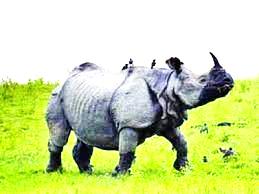Rhino Horns are Shrinking | 03 Nov 2022
For Prelims: Biodiversity & Environment, Conservation, IUCN Red List, Indian Rhino Vision 2020.
For Mains: Rhinoceroses, its species, threats and conservation.
Why in News?
According to a recent study, the horns of Rhinoceroses may have become smaller over time due to selective pressure of hunting.
- The study used an interesting research approach—analyzing artwork and photographs of the animal spanning more than five centuries.
- The study relied on a repository of images maintained by the Netherlands-based Rhino Research Center (RRC).
What are the Findings?
- The five surviving rhino species (White and Black Rhinos in Africa, and the Greater one-horned, Javan and Sumatran rhino species in Asia) are still threatened by habitat loss and hunting.
- The rate of decline in horn length was highest in the critically-endangered Sumatran rhino and lowest in the white rhino of Africa, which is the most commonly found species both in the wild and in captivity.
- This observation follows patterns seen in other animals, such as tusk size in elephants and horn length in wild sheep, which have been driven down by directional selection due to trophy hunting
- During the age of European imperialism (between the 16th and 20th centuries), rhinos were commonly portrayed as hunting trophies, but since the mid-20th century, they have been increasingly portrayed in a conservation context, reflecting a change in emphasis from a more to less consumptive relationship between humans and rhinos.
What are the Key Facts about Rhino?
- About:
- There are five species of rhino – white and black rhinos in Africa, and the greater one-horned, Javan, and Sumatran rhino species in Asia.
- IUCN Red List Status:
- Black Rhino: Critically endangered. Smaller of the two African species.
- White Rhino: Near Threatened. Researchers have created an embryo of the northern white rhino by using In Vitro Fertilization (IVF) process.
- One-Horned Rhino: Vulnerable
- Javan: Critically Endangered
- Sumatran Rhino: Critically Endangered. It has gone extinct in Malaysia.
- Indian Rhino:
- About
- Only the Great One-Horned Rhino is found in India.
- Also known as Indian rhino, it is the largest of the rhino species.
- It is identified by a single black horn and a grey-brown hide with skin folds.
- They primarily graze, with a diet consisting almost entirely of grasses as well as leaves, branches of shrubs and trees, fruit, and aquatic plants.
- About
-
- Habitat:
- The species is restricted to small habitats in Indo-Nepal terai and northern West Bengal and Assam.
- In India, rhinos are mainly found in Assam, West Bengal and Uttar Pradesh.
- Assam has an estimated 2,640 rhinos in four protected areas, i.e. Pabitora Wildlife Reserve, Rajiv Gandhi Orang National Park, Kaziranga National Park, and Manas National Park.
- About 2,400 of them are in the Kaziranga National Park and Tiger Reserve (KNPTR).
- Protection Status:
- IUCN Red List: Vulnerable.
- CITES: Appendix I.
- Wildlife Protection Act, 1972: Schedule I.
- Threats:
- Poaching for the horns
- Habitat loss
- Population density
- Decreasing Genetic diversity.
- Habitat:
What are the Conservation Efforts in India?
- The five rhino range nations (India, Bhutan, Nepal, Indonesia and Malaysia) have signed a declaration ‘The New Delhi Declaration on Asian Rhinos 2019’ for the conservation and protection of the species.
- In 2019, the Ministry of Environment Forest and Climate Change (MoEFCC) has begun a project to create DNA profiles of all rhinos in the country.
- National Rhino Conservation Strategy: It was launched in 2019 to conserve the greater one-horned rhinoceros.
- Indian Rhino Vision 2020: Launched in 2005, it was an ambitious effort to attain a wild population of at least 3,000 greater one-horned rhinos spread over seven protected areas in the Indian state of Assam by the year 2020.
UPSC Civil Services Examination Previous Year Question:
Q. Consider the following statements: (2019)
- Asiatic lion is naturally found in India only.
- Double-humped camel is naturally found in India only.
- One-horned rhinoceros is naturally found in India only.
Which of the statements given above is/are correct?
(a) 1 only
(b) 2 only
(c) 1 and 3 only
(d) 1, 2 and 3
Ans: (a)

